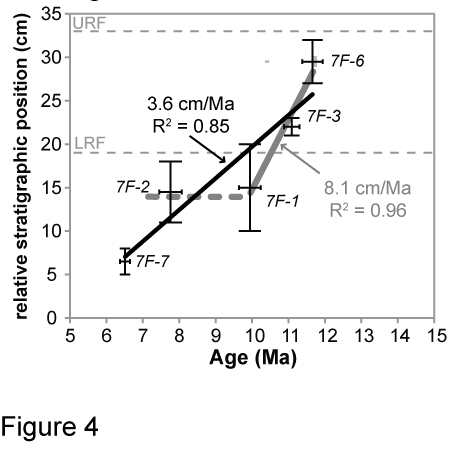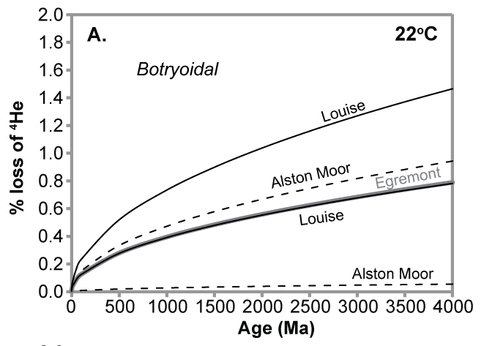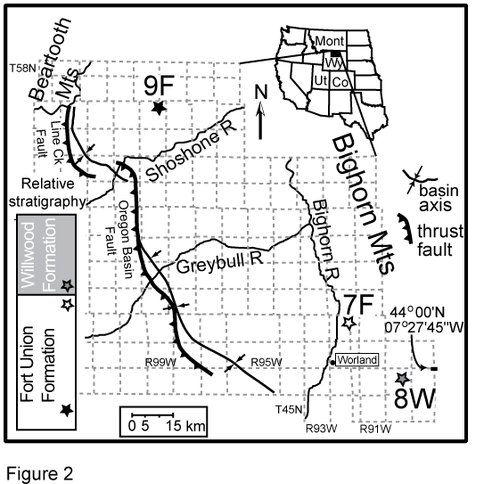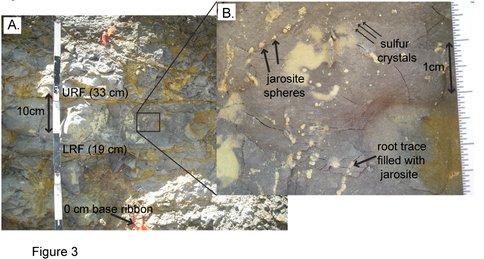2012 Annual Science Report
 Rensselaer Polytechnic Institute
Reporting | SEP 2011 – AUG 2012
Rensselaer Polytechnic Institute
Reporting | SEP 2011 – AUG 2012
Project 5: Vistas of Early Mars: In Preparation for Sample Return
Project Summary
To understand the history of life in the solar system requires knowledge of how hydrous minerals form on planetary surfaces, and the role minerals may play in the development of potential life forms. The minerals hematite and jarosite have been identified on Mars and presented as in situ evidence for aqueous activity. This project seeks to understand (i) the conditions required for jarosite and hematite formation and preservation on planetary surfaces, and (ii) the conditions under which their “radiometric clocks” can be reset (e.g., during changes in environmental conditions such as temperature). By investigating the kinetics of noble gases in minerals, known to occur on Mars and Earth, we will be prepared to analyze and properly interpret ages measured on samples from future Mars sample return missions.
Project Progress
The stability of minerals on planetary surfaces is dependent upon reactions with the atmosphere and hydrosphere over geologic time. The minerals jarosite and hematite form on planetary surfaces (i.e. on Earth and Mars) and require the presence of water. However hematite precipitation tends to be associated with water saturation of host sediments while jarosite precipitation occurs during drying conditions followed by sustained aridity. Both of these minerals have been employed as reliable chronometers on Earth (e.g., Wernicke and Lippolt, 1993; Vasconcelos et al., 1994). The K-bearing variety of jarosite can be dated by the 40Ar/39Ar method and hematite can be dated by the (U-Th)/He method. Because of the differences in their respective required aqueous conditions for formation, hematite and jarosite ages could be used to date surface processes such as weathering and environmental transitions (i.e. saturation to aridification) on Earth and Mars. To prepare for future Mars sample return missions and in-situ robotic analyses and to better interpret jarosite and hematite ages from a kinetic perspective, we have re-evaluated the diffusion kinetics of helium in hematite to assess retention of He in hematite over geological timescales at Mars surface conditions (Figure 1; Kula & Baldwin, 2012). An analogue study of jarosite on Earth, from the Eocene Willwood and Paleocene Fort Union Formations in the Bighorn Basin of Wyoming (Figure 2) was used to assess the potential for jarosite ages to be used to determine the rate of environmental transitions on Mars
Helium diffusion kinetics for botryoidal hematite indicate quantitative retention over geologic timescales on Earth (Lippolt et al., 1993; Bahr et al., 1994). Downward extrapolation of these parameters to Martian surface temperatures (≤ 22°C) predicts <2% fractional loss of He over 4.0 Ga (Figure 1). Hematite spherules at Meridiani Planum have been interpreted to form while the host sediments were saturated with groundwater (Grotzinger et al., 2005). Therefore, (U-Th)/He ages measured on hematite spherules may constrain the timing of water presence at Meridiani.
As a proof of concept for applying jarosite 40Ar/39Ar chronometry to constrain the timing and rates of aridification for once-aqueous environments, a vertical profile of jarosite-bearing samples was collected from the Eocene Willwood and Paleocene Fort Union Formations in the Bighorn Basin of Wyoming (Figure 2). These formations consist of interbedded fluvial sheet sandstones and floodplain mudstones. Paleosols developed on the fine-grained floodplain deposits contain rhizoliths, goethite and hematite, and jarosite indicating a general history of deposition, water saturation and soil formation, burial with sustained saturation, and finally excavation and drainage. This hydrologic sequence of saturation followed by drainage and sustained aridity is similar to that interpreted for the stratigraphy exposed at Burns Cliff at Meridiani Planum (Grotzinger et al., 2005).
From top to bottom through the sampled stratigraphy, jarosite ages systematically decrease from 52 to 5 Ma. This age progression is consistent with the interpretation that the jarosite formed during drainage and oxidation of pyrite following sustained saturation (Kraus, 1998; Kraus and Hasiotis, 2006). Jarosite precipitation in this way is a time-transgressive process where the oldest jarosite (first-formed) should be at the top of the section and progressively younger jarosite should be present down section. These results support a downward migrating jarosite precipitation front through the sedimentary column.
Plagioclase feldspar has been found in Meridiani planum on Mars (Glotch et al. 2006) and in Martian meteorites (McSween and Treiman 1998). The thermal emission spectrometer on Mars Global surveyor suggests that plagioclase is present in the Martian crust with an average composition of ~ An60 (Milam et al. 2010). While 40Ar/39Ar experiments on plagioclase can potentially be used to constrain the timing of local/regional/global volcanic activity and release of volatiles to the atmosphere, only one study of the kinetics of Ar in plagioclase has been published (Cassata et al., 2009). Diffusion experiments of argon in plagioclase feldspar are in the planning stages to assess this mineral’s reliability to record thermal histories at conditions relevant to the surface of Mars.
Figure 3 At the upper Fort Union location (see Figure 2), 5 jarosite samples were collected along a 25 cm vertical profile shown here.

Figure 4 Jarosite ages systematically decrease down section indicating the jarosite precipitation front migrated downward through the section at an average rate of 3.6 cm/Ma. The precipitation front likely reflects slow drainage through this portion of the sedimentary column. This result indicates that jarosite dissolution rates may be slower than those derived from laboratory experiments and that jarosite ages can record geologically slow environmental transitions over very small spatial distributions. Additionally, results indicate that jarosite-bearing samples retrieved by future Mars sample return missions can be used to determine when, and how long, water existed at the Martian surface.
References:
Bahr, R., Lippolt, H.J., Wernicke, R.S., 1994, Temperature-induced 4He degassing of specularite and botryoidal hematite: a 4He retentivity study: Journal of Geophysical Research, v. 99, p. 17695-17707.
Cassata, W.S., Renne, P.R., Schuster, D.L., 2009, Argon diffusion in plagioclase and implications for thermochronometry: a case study from the Bushveld Complex, South Africa, GCA, 73, 6600-6612.
Glotch, T. D., J. L. Bandfield, P. R. Christensen, W. M. Calvin, S. M. McLennan, B. C. Clark, A. D. Rogers, and S. W. Squyres (2006), Mineralogy of the light-toned outcrop at Meridiani Planum as seen by the Miniature Thermal Emission Spectrometer and implications for its formation, J. Geophys. Res., 111, E12S03, doi:10.1029/2005JE002672.
Kula, J., Baldwin, S.L., 2012, On hematite as a target for dating aqueous conditions on Mars: Planetary and Space Science, v. 67, p. 101-108.
Kraus, M.J., 1998, Developent of potential acid sulfate paleosols in Paleocene floodplains, Bighorn Basin, Wyoming, USA: Palaeogeography, Palaeoclimatology, Palaeoecology, v. 144, p. 203-224.
Kraus, M.J., Davies-Vollum, K.S., 2004, Mudrock-dominated fills formed in avulsion splay channels: examples from the Willwood Formation, Wyoming: Sedimentology, v. 51, p. 1127-1144.
Kraus, M.J., Hasiotis, S.T., 2006, Significance of different modes of rhizolith preservation to interpreting paleoenvironmental and paleohydrologic settings: examples from Paleogene paleosols, Bighorn Basin, Wyoming, U.S.A.: Journal of Sedimentary Research, v. 76, p. 633-646.
Lippolt, H.J., Wernicke, R.S., Boschmann, W., 1993, 4He diffusion in specular hematite: Physics and Chemistry of Minerals, v. 20, p. 415-418.
Grotzinger, J.P., et al., 2005, Stratigraphy and sedimentology of a dry to wet eolian depositional system, Burns formation, Meridiani Planum, Mars: Earth and Planetary Science Letters, v. 240, p. 11-72.
McSween H. Y., and Treiman A H., (1998) Martian meteorites, Planetary Materials: Reviews in mineralogy, Vol. 36 pp. 6-01,6-54.
Milam, K. A., H. Y. McSween Jr., J. Moersch, and P. R. Christensen (2010), Distribution and variation of plagioclase compositions on Mars, J. Geophys. Res., 115, E09004, doi:10.1029/2009JE003495.
Vasconcelos, P., Brimhall, G., Becker, T., Renne, P., 1994, 40Ar/39Ar analysis of supergene jarosite and alunite: implications to the paleoweathering history of the western USA and West Africa: Geochimica et Cosmochimica Acta, v. 58, p. 401-420.
Wernicke, R.S., Lippolt, H.J., 1993, Botryoidal hematite from the Schwarzwald (Germany): heterogeneous uranium distributions and their bearing on the helium dating method: Earth and Planetary Science Letters, v. 114, p. 287-300.
Publications
-
Kula, J., & Baldwin, S. L. (2012). On hematite as a target for dating aqueous conditions on Mars. Planetary and Space Science, 67(1), 101–108. doi:10.1016/j.pss.2012.03.005
-
PROJECT INVESTIGATORS:
-
PROJECT MEMBERS:
John Delano
Co-Investigator
Bruce Watson
Co-Investigator
Jayesh Das
Postdoc
Joseph Kula
Postdoc
David Gombosi
Graduate Student
-
RELATED OBJECTIVES:
Objective 1.1
Formation and evolution of habitable planets.
Objective 2.1
Mars exploration.
Objective 7.1
Biosignatures to be sought in Solar System materials


